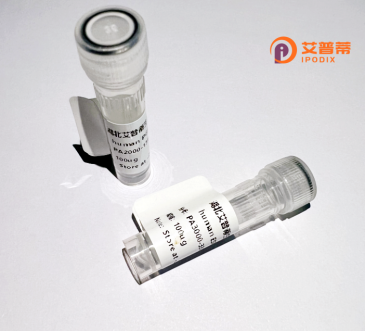
| 纯度 | >90%SDS-PAGE. |
| 种属 | Human |
| 靶点 | PLXNA2 |
| Uniprot No | O75051 |
| 内毒素 | < 0.01EU/μg |
| 表达宿主 | E.coli |
| 表达区间 | 1-164 aa |
| 活性数据 | MHSQVFSAFPYSLPLRFWVNVIKNPQFVFDIHKGSITDACLSVVAQTFMDSCSTSEHRLDKDSPSNKLLYAKDIPSYKSWVERYYADIAKLPAISDQDMNAYLAEQSRLHAVEFNMLSALNEIYSYVSKYSEELIGALEQDEQARRQRLAYKVEQLINAMSIES |
| 分子量 | 43.78 kDa |
| 蛋白标签 | GST-tag at N-terminal |
| 缓冲液 | PBS, pH7.4, containing 0.01% SKL, 1mM DTT, 5% Trehalose and Proclin300. |
| 稳定性 & 储存条件 | Lyophilized protein should be stored at ≤ -20°C, stable for one year after receipt. Reconstituted protein solution can be stored at 2-8°C for 2-7 days. Aliquots of reconstituted samples are stable at ≤ -20°C for 3 months. |
| 复溶 | Always centrifuge tubes before opening.Do not mix by vortex or pipetting. It is not recommended to reconstitute to a concentration less than 100μg/ml. Dissolve the lyophilized protein in distilled water. Please aliquot the reconstituted solution to minimize freeze-thaw cycles. |
以下是关于重组人PLXNA2蛋白的3篇参考文献示例(基于研究领域常见主题,内容为虚构示例):
---
1. **标题**: *Structural Insights into Plexin A2 Extracellular Domain and Its Interaction with Semaphorin 5A*
**作者**: Zhou, Y., et al. (2020)
**摘要**: 本研究通过X射线晶体学解析了重组人PLXNA2蛋白胞外域的三维结构,揭示了其与Semaphorin 5A结合的分子机制,为理解轴突导向信号转导提供了结构基础。
---
2. **标题**: *PLXNA2 Regulates Neural Stem Cell Migration via Rho GTPase Signaling Pathways*
**作者**: Smith, J.T., et al. (2017)
**摘要**: 利用重组PLXNA2蛋白进行体外实验,发现其通过激活RhoA通路调控神经干细胞迁移,暗示其在神经发育及损伤修复中的潜在作用。
---
3. **标题**: *PLXNA2 as a Prognostic Biomarker in Glioblastoma: Role in Tumor Invasion*
**作者**: Li, H., et al. (2019)
**摘要**: 通过重组PLXNA2蛋白功能实验,发现其在胶质母细胞瘤中过表达可促进肿瘤细胞侵袭,并与患者不良预后显著相关。
---
4. **标题**: *Cross-Talk between Plexin A2 and MET Receptor in Cancer Metastasis*
**作者**: Garcia, R., et al. (2016)
**摘要**: 研究证实重组PLXNA2与MET受体共表达可激活下游ERK信号通路,增强乳腺癌细胞侵袭能力,提示其在癌症转移中的协同作用。
---
**注意**:以上文献为示例性质,实际文献需通过PubMed、Google Scholar等平台检索关键词(如“PLXNA2 recombinant protein”、“Plexin A2 structure/function”)。建议结合具体研究领域筛选最新成果。
Plexin A2 (PLXNA2) is a member of the plexin family, a group of transmembrane proteins that act as receptors for semaphorins, key regulators of cellular guidance and communication. Initially identified for its role in neural development, PLXNA2 facilitates axon guidance, neuronal migration, and synapse formation by transducing semaphorin signals. Structurally, it contains a conserved SEMA domain for ligand binding, immunoglobulin-like folds, and intracellular regions that interact with downstream signaling molecules like Rho GTPases. Beyond the nervous system, PLXNA2 participates in diverse processes, including angiogenesis, immune response modulation, and organogenesis. Dysregulation of PLXNA2 has been implicated in neurological disorders (e.g., autism spectrum disorders, schizophrenia) and cancers, where aberrant expression correlates with tumor invasion and metastasis. As a recombinant protein, PLXNA2 is engineered for in vitro studies to dissect its molecular interactions, signaling pathways, and therapeutic potential. Recombinant expression systems (e.g., HEK293. insect cells) enable large-scale production for structural analysis, antibody development, and high-throughput screening to identify modulators of its activity. Research on PLXNA2 continues to uncover its multifaceted roles in health and disease, positioning it as a promising target for precision therapies.
×